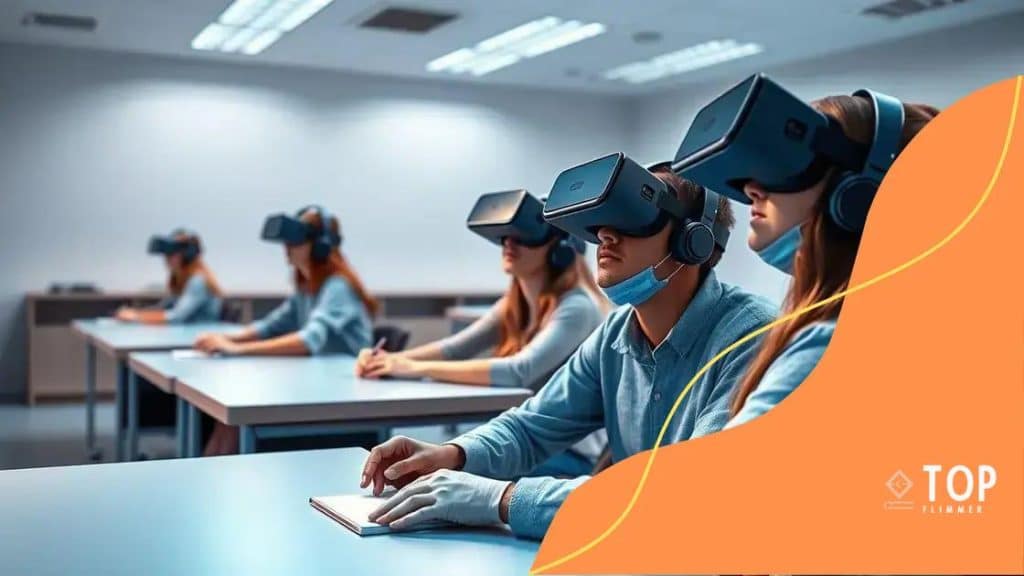Educating in the Metaverse: Unveiling the Potential

Educating in the metaverse enhances learning through immersive experiences, fostering collaboration and engagement, while addressing challenges such as access and training for educators to maximize its potential in shaping the future of education.
Educating in the Metaverse is a rapidly growing concept that combines virtual reality and augmented reality to enhance learning experiences. Have you ever wondered how this digital space can reshape the way we learn and teach? Let’s dive into the opportunities and challenges it presents.
Understanding the metaverse in education
The metaverse is a digital universe encompassing virtual and augmented realities. In education, it fundamentally transforms how learners engage and interact with content. Understanding how the metaverse works in this context is essential for educators and students alike.
What is the Metaverse?
The metaverse is an immersive environment where users can socialize, create, and learn. It combines elements of the internet, such as social media, with virtual reality experiences. This blended reality enables learners to explore concepts practically and interactively.
Advantages of Using the Metaverse in Education
When we integrate the metaverse into the learning process, we provide unique opportunities for growth:
- Enhanced Engagement: The interactive nature of the metaverse keeps students motivated.
- Immersive Learning: Learners can participate in simulations that bring lessons to life.
- Global Collaboration: Students from different parts of the world can work together in real-time.
- Freedom to Experiment: In a virtual space, students can practice skills without real-world consequences.
Furthermore, the metaverse allows for personalized learning experiences. Educators can tailor activities to each student’s needs, interests, and learning pace. This adaptability can significantly improve understanding and retention of information.
Outside traditional subjects, the metaverse can support social-emotional learning. Through various scenarios, students can practice empathy and decision-making. This is essential for developing well-rounded individuals ready for the challenges of the real world.
Challenges to Consider
While the metaverse offers impressive potentials, it also brings challenges. For instance, access to technology and internet connectivity can hinder some students. Furthermore, educators must be adequately trained to guide students in these new environments.
In conclusion, grasping the metaverse’s role in education opens up vast opportunities for enhancing learning experiences. As we move forward, it will be important to address challenges and ensure that all students benefit from these innovative approaches.
Benefits of immersive learning experiences
Immersive learning experiences revolutionize education by engaging students in ways traditional methods cannot. This approach encourages deeper understanding and retention of knowledge through interactive participation.
Engagement and Motivation
One of the primary benefits of immersive learning is the enhanced engagement it offers students. When learners actively participate in their education, they feel more motivated. This engagement leads to:
- Increased Focus: Students are less likely to be distracted when involved in an interactive learning environment.
- Greater Interest: Active participation fosters curiosity and interest in various subjects.
- Improved Collaboration: Students often work together, enhancing interpersonal skills.
Furthermore, immersive experiences allow students to connect concepts to real-world applications. For example, when using virtual reality, they can explore historical events or scientific phenomena firsthand, deepening their understanding.
Enhanced Learning Retention
Immersive learning also significantly improves information retention. Students are more likely to remember what they learn when they can engage with it practically. Unlike traditional lectures where information may be forgotten quickly, immersive environments facilitate:
- Experiential Learning: Learners apply knowledge in realistic scenarios, reinforcing their skills.
- Multisensory Engagement: Using various senses results in a richer learning experience.
- Personal Connections: Students form emotional ties to the material, especially when they can visualize and experience it.
These connections promote a longer-lasting understanding of the subject matter. Imagine learning about ecosystems by walking through a simulated rainforest rather than just reading about it in a textbook. This way, learners grasp concepts and see their relevance.
The adaptability of immersive learning experiences caters to various learning styles. Some students thrive in visual settings, while others benefit from hands-on activities. By providing a range of immersive methods, educators can engage every student more effectively.
Challenges faced in metaverse education

Despite its potential, metaverse education faces several challenges that can hinder its effectiveness. Understanding these obstacles is crucial for educators and institutions looking to implement this technology successfully.
Access and Equity Issues
One major challenge is the disparity in access to technology. Not all students have the necessary devices or reliable internet connections. This creates a digital divide where only some can benefit from immersive learning experiences.
- Device Availability: Many students may lack access to VR headsets or computers capable of supporting metaverse platforms.
- Internet Connectivity: Poor or nonexistent internet service can prevent students from participating in virtual learning.
- Cost Barriers: Schools may struggle with the costs associated with implementing metaverse technologies, such as software licenses and hardware purchases.
Additionally, these inequities can affect student engagement and motivation. When some students can’t participate fully, it can lead to feelings of isolation and exclusion.
Training and Support for Educators
Another significant challenge is the need for adequate training and ongoing support for educators. Not all teachers are familiar with metaverse education, which can lead to underutilization of the tools available.
- Professional Development: Many educators may need extensive training to feel comfortable using new technologies.
- Technical Support: Ongoing assistance is vital for troubleshooting issues that arise during lessons.
- Curriculum Alignment: Educators must find ways to align metaverse activities with existing curriculum standards effectively.
Without proper training, teachers may struggle to integrate these new tools into their lessons, limiting their effectiveness. Thus, schools must prioritize training and support to maximize the potential of immersive learning.
Safety and Privacy Concerns
While exploring the metaverse, safety and privacy concerns emerge as significant issues. Ensuring a secure learning environment is essential for students.
- Data Security: Protecting student information from unauthorized access is critical.
- Inappropriate Content: There is a risk that students may encounter unsuitable material in open virtual spaces.
- Cyberbullying: As with all online environments, the possibility of cyberbullying exists, posing a threat to students’ emotional well-being.
Schools need to establish clear guidelines and policies to create a safe learning environment in the metaverse. This also includes educating students about responsible online behavior.
Real-world applications and success stories
The metaverse is not just a concept; it has practical applications in education that are already making a significant impact. Various institutions are adopting metaverse technologies to enhance learning experiences.
Case Studies in Education
Several schools and universities have successfully implemented immersive learning experiences in the metaverse. For example, a university in California developed a virtual campus where students can attend lectures, interact with peers, and collaborate on projects in a 3D environment.
- Virtual Field Trips: Schools have used the metaverse to take students on virtual field trips, from exploring ancient ruins to wandering through museums around the world.
- Simulated Labs: In science education, students have engaged in simulated experiments that allow them to explore chemical reactions safely without the risks associated with real-life laboratories.
- Language Learning: Language courses have embraced the metaverse, using virtual environments to practice conversational skills with native speakers.
These real-world applications demonstrate the versatility of the metaverse in various educational contexts. Furthermore, success stories continue to emerge, enriching our understanding of effective learning strategies.
Innovation and Collaboration
Collaboration is key in the metaverse. Students can work together in virtual environments on projects, no matter their physical location. This fosters teamwork and enhances communication skills. A notable success story involves students from different countries collaborating on a science project in a shared virtual lab. They used simulations to test their hypotheses, developing a deeper understanding of scientific principles while building friendships across borders.
Moreover, companies are beginning to partner with educational institutions to provide resources and expertise. For example, tech firms have developed tools specifically for classroom use in the metaverse, ensuring that educators have access to the latest technologies.
Future Prospects
The future of metaverse education looks promising. As more success stories surface, educational institutions are likely to invest in this technology to enhance learning. Early adopters are paving the way, demonstrating that immersive experiences can lead to better engagement and learning outcomes.
With the right resources and commitment to overcoming challenges, the potential of the metaverse in education continues to grow. In upcoming years, we can expect to see even more innovative applications that push the boundaries of traditional learning.
The future of learning in the metaverse
The future of learning in the metaverse holds exciting possibilities that can redefine how we educate our students. As technology advances, educational institutions are exploring innovative ways to enhance engagement and interactivity.
Innovative Learning Environments
Virtual classrooms in the metaverse provide dynamic environments where students can learn together, regardless of location. Intuitive interfaces allow learners to interact with 3D models, offering a hands-on approach to complex subjects. Imagine studying biology by virtually exploring the human body or learning history through immersive experiences in ancient civilizations.
- Personalized Learning: The metaverse adapts to student needs, tailoring lessons that match their individual learning styles.
- Global Collaboration: Students from different parts of the world can work together on projects, sharing diverse perspectives.
- Instant Feedback: Educators can track student progress in real-time, providing immediate insights and support.
These features not only enhance learning but also foster a sense of community among students, which is essential for motivation and growth.
Integration with Emerging Technologies
As we look to the future, the integration of emerging technologies such as artificial intelligence (AI) and augmented reality (AR) will further enhance metaverse experiences. AI can personalize learning by adapting content and assessments, making the educational journey more efficient for each student. Meanwhile, AR can increase engagement by overlaying digital information onto the physical world, creating enriched learning experiences.
For example, students could use AR to visualize data in real-time during science experiments, bridging the gap between theory and practical application. Such interactions encourage curiosity and critical thinking, essential skills for future innovators.
Potential Challenges to Overcome
While the prospects are exciting, challenges remain for the future of metaverse learning. Issues regarding accessibility, equity, and the need for teacher training must be addressed for the full potential to be realized. Schools will need to ensure that all students have access to the necessary technology and internet connections to participate actively in these virtual spaces.
Moreover, professional development for educators will be vital to harness the power of the metaverse effectively. As teachers become more adept at using these technologies, they will be better prepared to guide their students toward successful learning outcomes.
The potential of the metaverse in education is vast and inspiring. It offers immersive learning opportunities that can transform how students engage with content, making education more interactive and enjoyable. By embracing this technology, schools and teachers can create unique environments where students learn collaboratively and effectively. However, it is essential to address the challenges such as access and training for educators. As institutions continue to innovate, the future of learning in the metaverse promises to be bright, opening doors to endless possibilities for learners around the globe. 🌍
FAQ – Frequently Asked Questions about Learning in the Metaverse
What is metaverse education?
Metaverse education refers to immersive learning experiences that take place in virtual environments, allowing students to engage with content interactively.
How does the metaverse enhance student collaboration?
The metaverse allows students from different locations to work together on projects in real-time, promoting teamwork and diverse perspectives.
What are the main challenges of implementing metaverse education?
Key challenges include access to technology, training for teachers, and ensuring a safe and inclusive learning environment.
What is the future of learning in the metaverse?
The future looks promising, with continuous advancements in technology and innovative applications that will further enhance the educational experience.






